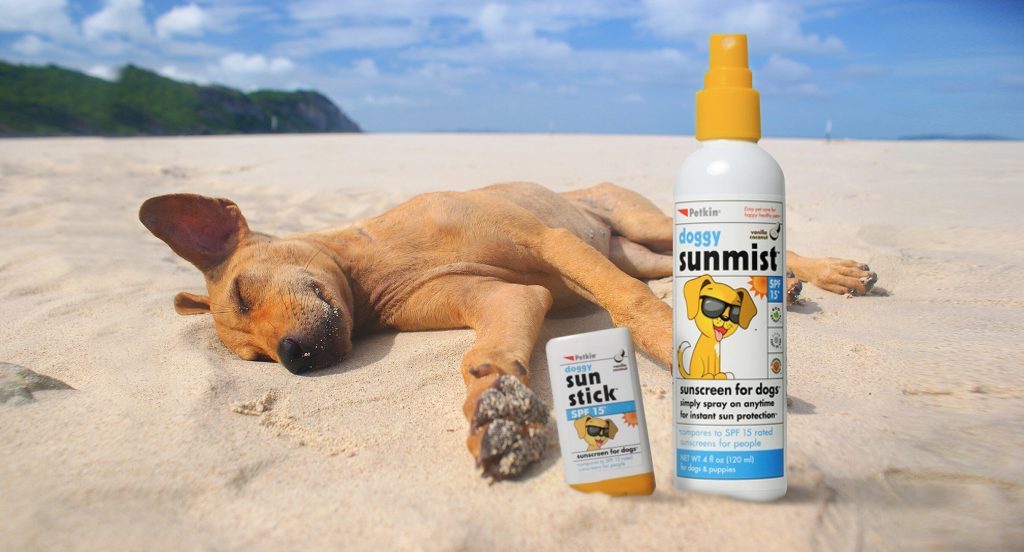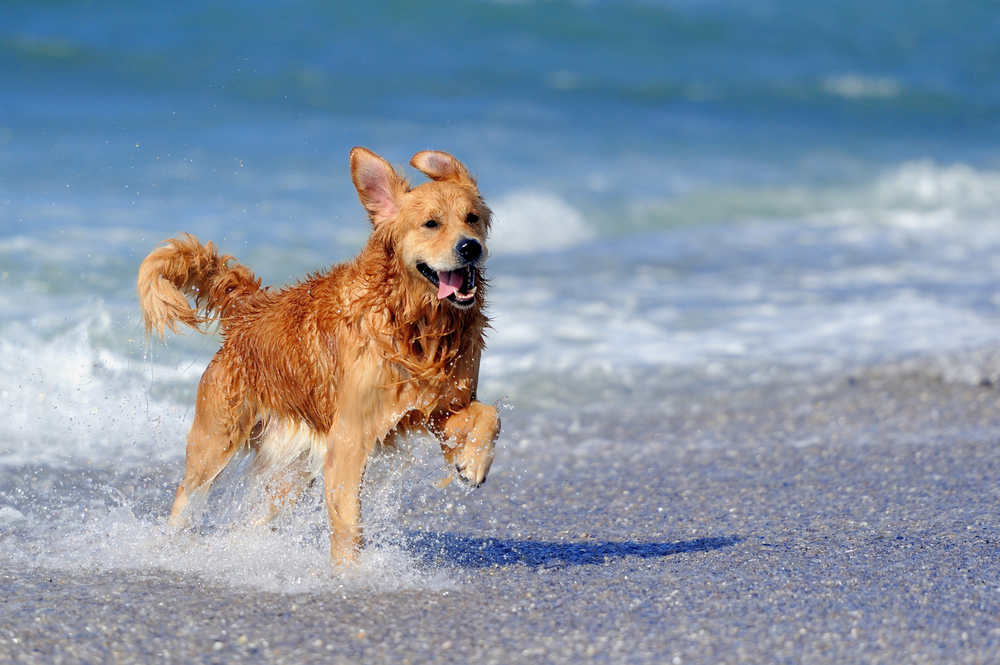As summer approaches, we want to spend more time outside with our pets. Not only is sunshine a mood-booster, it also provides a healthy dose of vitamin D. But like humans, UV rays from the sun also bring some unwanted effects, such as sunburn.
Protecting your pup from harmful UV rays is crucial for their health. With growing awareness, more and more people ask, “Can a dog get sunburn?” and “How can I protect my pup.” That’s why Mad Paws Pet Store offers a range of sunscreen for dogs.
Still, with myths and misinformation floating around the internet, it can be challenging to choose the right product. So, let’s explore how you can best protect your pup.
 Understanding sunburn in dogs
Understanding sunburn in dogs
You may ask, “Can a dog get sunburn?” The simple answer is yes. However, the more important thing to understand is how this happens and the steps you can take to prevent it. Unfortunately, there are several misconceptions regarding dogs and sunburn.
Can I use human sunscreen on a dog?
Firstly, human sunscreens are not suitable for animals. Dogs should use specifically formulated products that eliminate zinc oxide and para-aminobenzoic acid (PABA). Dogs often lick their skin and are likely to ingest small amounts of sunscreen. Both zinc and PABA are toxic.
Does fur protect dogs from heat?
Your dog’s coat helps combat overheating but does not block out UV rays. Long fur offers good protection against overheating and sunburn but doesn’t offer complete protection against UVA and UVB rays.
Summer hazards for dogs
There are some hazards you might not think about. Hot roads and pathways can burn the paw pads. An easy way to test this is to place your bare foot on the path; if it’s too hot for you, it is too hot for your dog.
Also, animals can burn through glass. This is more common for indoor cats who spend hours bathing on windowsills, but it’s also possible for dogs to burn this way.
It’s not just sunburn that is a risk, either. Dehydration can make an animal sick, while heatstroke can lead to seizures. If you’re taking a trip to the beach, plan for a safe day.
Risk factors for sunburn in dogs
Before we discuss the risk factors for sunburn in dogs, it’s important to remember this:
All dogs are at risk of sunburn, which can cause health issues and lead to cancer.
One risk factor for sunburn is your dog’s breed. Hairless dogs and those with white coats, thin coats, or light-pigmented noses and eyelids are at greater risk.
What breed of dog gets sunburn?
- Boxers
- Bull terriers
- Chihuahuas
- Collies
- Dalmations
- French bulldogs
- Greyhounds
- Pitbulls
- Whippets
Certain factors can also affect your dog’s susceptibility to sunburn:
- Dogs with white fur tend to have paler skin, increasing their sunburn risk.
- The thinner the fur, the more skin is exposed. Hairless dogs are particularly susceptible.
- Medical conditions that lead to hair loss. These include allergies, skin parasites, and hormonal imbalances.
- Immune conditions that decrease skin pigmentation. These include lupus, which also reduces your dog’s natural sun protection.
- Animals with areas of scar tissue.
- Dogs that engage in “risky behaviours” such as sunbaking or regularly exposing their bellies.
In addition, all dogs have vulnerable areas, including the belly, ears, and nose. You also remove some of your dog’s sun protection if you shave them during the summer. If you decide to shave your pet, it’s worth consulting your vet to weigh up the pros and cons of your decision.
How to protect your dog from sunburn
Use pet-friendly sunscreen around vulnerable areas like the belly, ears and nose. While sunburn can occur on any part of your dog’s body, it is more common in the following areas:
- The ear flaps
- The nose bridge
- Thin-haired parts of the face, like the areas near the mouth and eyes
- The belly and groin, particularly if your dog sunbathes on their back, exposing this area.
1. Avoid peak sun hours
We all want to make the most of summertime by engaging in fun outdoor activities with our pups, but avoiding peak sunshine hours helps limit sun exposure. If you have to take your dog out between 10 a.m. and 4 p.m., provide shade and use dog-friendly sunscreen. Ideally, take your dog for a walk during the cooler morning and evening hours.
If you’re heading out for the day, make sure you provide appropriate shade and plenty of fresh water. This is especially important if your dog is engaging in outdoor activities. The heat can quickly cause exhaustion if they don’t stay hydrated.
Use protective clothing and even doggy sunglasses to protect your pup from harmful UV rays. Rashies, sunsuits, hats, and glasses are all good options, depending on what your dog is comfortable wearing.
2. Choose a pet-safe sunscreen
When choosing sunscreen for your dog (or cat), it’s vital to pick a safe product. The best way to do this is to purchase a dog-specific cream specially formulated for canines. Still, it’s important to remember that all dogs are different, and some can react to certain products.
Before applying, test a small amount of cream on one patch of the skin to monitor for allergies. As long as your dog doesn’t react, you can go ahead and apply it to their vulnerable body areas, plus any places where they have light pigmentation.
While you may apply sunscreen to the nose bridge and ear flaps, you must avoid the eyes and surrounding areas. If sunscreen gets into your dog’s eyes, it can cause irritation. Additionally, monitor your dog until the cream dries to ensure it doesn’t lick it all off.
If your dog has wounds or skin conditions, try applying a sun filter and antibacterial cream. These products act like a second skin, keeping out dirt while retaining moisture. In addition, a sun filter cream helps protect your dog’s skin against harmful UV rays.

Image courtesy of https://www.cyddesign.com
How to put sunscreen on dogs:
Apply sunscreen roughly 20 minutes before your dog goes into the sun. Reapply every 4-6 hours and after your dog goes for a swim.
Brands like Petkin offer easy-to-apply sunscreen for dogs. You can choose a spray, wipe or stick for easy application, and the gentle, non-greasy formula was developed with dogs in mind.
If your dog attempts to lick the sunscreen, distract them with play. Even if the sunscreen is safe to consume, your dog will remove the layer of protection.
Signs of sunburn in dogs
Even if you apply sunscreen, your dog can still get sunburn. Dogs display similar symptoms to humans. These include:
- Dry, peeling or flaky skin.
- Blisters.
- Frequent scratching.
- Reddening areas of the skin.
- Tenderness around vulnerable areas.
- Rashes, wounds, and infections to the skin.
- Cracked or misshapen ear tips.
What can I put on my pet’s burn?
If your dog has a mild sunburn, you can take the following steps to soothe them:
- Keep them out of the sun and heat for a few days.
- Place a cool compress or wet towel on the affected areas to soothe the burn.
- Aloe vera can offer some soothing properties, but you should only use it in small amounts. It is toxic to dogs, so if you put it in an area they can lick, you risk poisoning them.
- Avoid giving your dog any medication before consulting with a vet. The wrong medication could exacerbate their symptoms.
Tip: it’s a good idea to keep a pet first aid kit handy to treat minor injuries quickly and safely.
When to seek veterinary care for severe sunburn
Severe sunburn can lead to fever, so in some instances you will need to consult a vet. Your vet can prescribe appropriate creams and medication to treat pain and soothe affected areas. If your dog is severely sunburned they may require additional fluids.
If you notice your dog whining, whimpering, or expressing pain when they move, it is definitely time to consult a vet.
Long-term health implications include melanoma and other types of skin cancer. The risk of cancer varies depending on the individual but decreasing your dog’s risk of sunburn is always beneficial. Seek advice immediately if your dog develops any masses or unusual skin changes.
Sun protection is vital for pets, especially in countries like Australia, where the sun can reach scorching temperatures. It only takes a few minutes of sun exposure for your dog to burn, so protective measures are essential.
If you’re planning a trip to the beach or other outdoor area, make sure you head to Mad Paws Pet Store to stock up on pet-friendly sunscreens and other essentials. Remember to share this article with your friends so that they, too, can keep their animals safe this summer.

